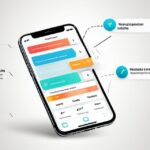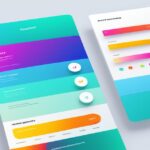Table of Contents
With the increasing importance of user-centric design in the digital realm, it’s crucial to focus on crafting interactive forms that drive better conversion rates. Whether you’re aiming to capture leads, make sales, or gather valuable data, optimizing your forms is key to achieving your goals.
Interactive forms that are designed with the user in mind create a seamless and intuitive experience, improving overall conversion rates. By implementing user-centric principles and strategies, such as understanding your audience, streamlining navigation, prioritizing visual hierarchy, optimizing for mobile devices, leveraging A/B testing, and providing seamless feedback, you can significantly enhance the effectiveness of your forms.
In this article, we will explore each of these strategies in detail, providing you with actionable tips and insights to help you craft user-centric interactive forms that drive conversion. By the end, you’ll be equipped with the knowledge and tools to create forms that not only engage your audience but also lead to tangible results. So, let’s dive in and discover the power of user-centric design in form conversion.
Understanding Your Audience
Before starting the design process, conducting thorough user research is essential. This research helps to identify the preferences, pain points, and behaviors of your target audience. By creating user personas based on specific characteristics and goals, you can tailor the UI to meet their expectations, increasing the likelihood of conversion.
Understanding your audience is the foundation of creating a successful user interface. By gathering insights through various research methods such as surveys, interviews, and data analysis, you gain valuable information about your users. This insight enables you to develop a deep understanding of their needs, motivations, and pain points.
“User personas are a powerful tool that helps us step into the shoes of our target audience and design experiences that truly resonate with them.”
Once you have gathered the necessary data, you can create user personas. User personas are fictional representations of your target audience, based on real user data. These personas capture the characteristics, goals, and behavior patterns of different segments within your target audience.
Each user persona represents a specific user group and helps you understand their unique needs, preferences, and expectations. By creating multiple personas, you can design a UI that caters to the diverse range of users interacting with your product or website.
For example, if you are designing an e-commerce website for a clothing brand, you might create personas like “Fashionable Fiona,” representing a trendy and style-conscious shopper, and “Budget-Savvy Sarah,” a price-conscious shopper looking for affordable options. These personas guide the design decisions made throughout the UI development process.
The user personas allow you to put yourself in the shoes of your target audience and make informed design choices that resonate with them. By understanding their motivations, pain points, and aspirations, you can create a UI that exceeds their expectations and drives higher conversion rates.
“User personas allow us to empathize with our target audience and ensure that our designs align with their needs and goals.”
By incorporating user research and utilizing user personas, you can create a user-centric UI that addresses the specific needs of your target audience. This approach will result in a more engaging and intuitive design, effectively capturing user attention and boosting conversion rates.
The Benefits of User Research and User Personas
Through user research and the creation of user personas, you can:
- Gain insights into user preferences, pain points, and behaviors.
- Understand the motivations and goals of your target audience.
- Identify and prioritize features that align with user needs.
- Create a UI that meets user expectations and enhances user experience.
- Improve conversion rates by tailoring the UI to specific user segments.
By investing time and effort into understanding your audience, you can create a user-centric UI that resonates with users and drives conversions.
An intuitive and user-friendly navigation system is crucial for a successful UI. To enhance user experience and increase conversion rates, it is important to streamline navigation by simplifying menus, using clear labels, and minimizing the number of clicks required to reach key pages. By implementing a logical flow in the UI, users can easily find what they are looking for and take the desired actions.
When designing the navigation structure, consider categorizing content in a way that is intuitive and makes sense to the target audience. Use clear and descriptive labels for menu items, ensuring that users understand the purpose and relevance of each page. Avoid overwhelming users with too many options and prioritize the inclusion of key pages that are essential for conversions.
One effective approach to streamline navigation is to use a hierarchical structure, with high-level categories guiding users to more specific pages. This helps users navigate through the website in a logical manner, providing a clear path to their desired destination. By organizing content in a user-friendly way, users can easily locate the information or products they are interested in, leading to a smoother conversion process.
Additionally, consider implementing breadcrumbs or a search bar to further enhance navigation. Breadcrumbs allow users to understand their current location within the website and easily navigate back to previous pages if needed. A search bar provides users with a quick and convenient way to search for specific content or products, reducing the time and effort required to find what they are looking for.
Effective navigation is like a roadmap for users, guiding them through your website with ease. A user-friendly navigation system creates a seamless flow, contributing to a positive user experience and higher conversion rates.
By prioritizing user-friendly navigation, implementing a logical flow, and ensuring easy access to key pages, you can create a UI that caters to the needs of your audience and maximizes conversion opportunities.
| Benefits of Streamlined Navigation | How to Achieve it |
|---|---|
| Enhanced user experience | Simplify menus |
| Increased engagement | Clear labels |
| Improved conversion rates | Minimize clicks |
| Implement logical flow | |
| Hierarchical structure | |
| Include breadcrumbs or search bar |
Prioritize Visual Hierarchy
In order to create a visually appealing and engaging user interface, it is essential to prioritize visual hierarchy. By using contrasting colors, varying font sizes, and strategically placing elements, you can effectively guide users’ attention and highlight important information and calls-to-action.
Contrasting colors play a crucial role in drawing attention and creating visual interest. By using colors that are visually distinct from one another, you can make important elements stand out and improve the overall readability of the UI.
Similarly, varying font sizes can help establish visual hierarchy and emphasize key points. By using larger fonts for headings and titles, you can make them more prominent and easily scannable for users. On the other hand, using smaller fonts for supporting text can create a harmonious balance and ensure that the content is easily readable.
In addition to colors and font sizes, strategic placement of elements is essential for capturing users’ attention. By placing important information and calls-to-action in prominent positions, such as at the top or center of the UI, you increase the chances of users noticing and engaging with them.
Organizing the content in a visually appealing manner not only enhances the overall user experience but also directs users’ attention to key conversion points. By carefully structuring the layout and using visual cues, you can guide users through the UI and encourage them to take the desired actions that lead to conversion.
Take a look at the example below to see how visual hierarchy can be applied in a user interface:
Aesthetic Appeal Example
In this example, contrasting colors are used to differentiate the various elements on the page. The use of a bold and larger font size for the headline immediately grabs the user’s attention. Important information, such as the main offer and call-to-action button, is strategically placed in the center of the page, making them hard to miss. This visually appealing design not only captures users’ attention but also directs them towards the desired action, increasing conversion rates.
Optimize for Mobile Devices
With the prevalence of mobile browsing, it is imperative to optimize your website’s user interface for different screen sizes. Responsive design plays a crucial role in ensuring a seamless experience for users across various devices, including desktops, tablets, and smartphones. By employing responsive design techniques, you can adapt your UI to fit different screen resolutions and orientations, providing a consistent and user-friendly layout. This enhances user engagement and encourages conversions regardless of the device they are using.
To ensure a truly seamless experience, it is vital to thoroughly test your UI on different devices. This allows you to identify and address any issues that may hinder the conversion process on mobile platforms. Testing across various screen sizes and operating systems helps you uncover potential layout and functionality inconsistencies. By rectifying these issues, you can provide a flawless user experience that caters to the unique requirements of different devices, driving higher conversion rates.
Remember, optimizing for mobile devices is more than just adapting the UI to fit different screens. It involves creating intuitive touch-based interactions, ensuring quick loading times, and optimizing the use of space on smaller screens. By prioritizing these aspects, you can deliver a seamless, user-centric experience that fosters engagement and encourages conversions, regardless of the device your users choose to access your website.
FAQ
What is the importance of designing user interfaces that convert users into customers?
Designing user interfaces that not only engage users but also convert them into customers is crucial for online success. It helps businesses attract and retain customers, ultimately leading to increased conversions and revenue.
Why is conducting thorough user research important before starting the design process?
Conducting thorough user research is essential as it helps identify the preferences, pain points, and behaviors of the target audience. This information enables businesses to create user personas and tailor the user interface to meet the expectations of their target audience, increasing the likelihood of conversion.
Navigation plays a crucial role in creating a successful user interface. By simplifying menus, using clear labels, and minimizing the number of clicks required to reach key pages, businesses can enhance user experience and encourage users to take desired actions, ultimately leading to higher conversion rates.
How does prioritizing visual hierarchy contribute to better user experience and conversion rates?
Prioritizing visual hierarchy is essential as it helps highlight important information and calls-to-action. By using contrasting colors, varying font sizes, and strategically placing elements, businesses can guide users’ attention to key conversion points, increasing the chances of conversion.
Why is it important to optimize the user interface for mobile devices?
With the prevalence of mobile browsing, optimizing the user interface for different screen sizes is crucial. Responsive design ensures a seamless experience across devices, allowing users to engage with the platform on desktops, tablets, and smartphones. This leads to improved user satisfaction and increased conversion rates.













